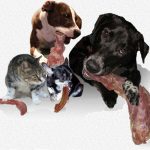Dental Problems in Your Dog, Cat or Ferret
Ron Hines DVM PhD
This is an older archived article of mine. No need to read it
 You will find a better and more extensive one here
You will find a better and more extensive one here
 Alternative ways to avoid dental problems here
Alternative ways to avoid dental problems here
One of the biggest problem causing tooth and gum disease in pets is that pet diets are formulated and textured to meet the desires of the pet’s owners – not for good oral hygiene.
The villain in tooth and gum disease in pets and people is plaques. Plaque is a mixture of remaining food, and salivary minerals mixed with bacteria and acids produced by the fermentation of food. These products slowly irritate the gums (periodontal disease), dissolve the teeth and cause bad breath.
Food particles tend to cling to the nooks and crannies which exist between the teeth. Some breeds of dogs and cats (Maltese terriers, Siamese cats, etc.) tend to have more dental disease. Feeding canned or soft diets increases the rate at which plaque is formed.
In ferrets, poor nutrition of the mother (the jill) or exceptionally large litters or the lack of dietary calcium can all contributes to later dental problems. Feeding dog chow rather than a high-protein premium low carbohydrate ferret or cat chow to ferret kits (babies) is also an invitation to later health issues.
Many products are available to prevent and control tartar and gum disease in pets. T/D is a dry food, produced by Hill’s Company. It is engineered to reduce plaque and tartar accumulation. But if the teeth are already loose, this food may cause the problem to get worse rather than better.
Another product, C.E.T. Chews™ is a freeze-dried fish treat that provides abrasive cleansing action as well as antibacterial enzymes to combat gingivitis other prescription chew brands are available.
The most important thing you can do to preserve your pet’s teeth is to include plenty of crunchy ingredients in your pet’s diet
It’s simply a matter of mechanics. A crunchy diet massages the gums and wears off plaque.
The second most important thing you can do is to purchase an ultra-soft pediatric toothbrush and brush your pet’s teeth twice a day with a toothpaste designed for pets. Some pets prefer the poultry flavor, others the beef. It is best if you begin this when your pet is a puppy or kitten so that it will learn to accept it without a struggle. When you brush, concentrate on the side of the tooth that is closest to the cheeks.
Remember, dental and gum disease is basically a matter of prevention. There is no cure – once it has begun we can only slow its progress. In toy and smaller breeds, ultrasonic or manual removal of plaque may be necessary. Some pets are good-natured enough to let you remove the tartar at home with a dental scraper – but most are not. If you do so, let a veterinary technician instruct you how and begin when the pet is very young.
What Commonly Causes Tooth and Gum Disease in Cats?
Feline granulomatous gum disease:
Feline granulomatous gum disease causes an inflammatory reaction around the roots of all teeth. The loss of gum tissue is most noticeable around the cat’s fangs. This disease is quite common in Siamese cats and cats that are positive for the feline AIDS virus (feline immunodeficiency virus). Some veterinarians have been successful in controlling this problem using feline omega interferon.
Plasmacytic-Lymphocytic Stomatitis:
In this condition, gum disease surrounding the bases of teeth of cats causes very bad breath, drooling and redness around the base of the teeth. These cats are often reluctant to eat and lose weight. This condition is caused by a number of factors, including feline calicivirus and most likely some that have yet to be discovered.
You are on the Vetspace animal health website
Visiting the products that you see displayed on this website help pay the cost of keeping these articles on the Internet.

